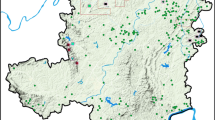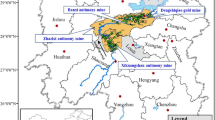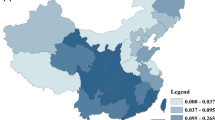Abstract
The rice contamination to heavy metals and its associated health risks have been less addressed in the southeast of Iran. In the present study, in the mentioned region, we assessed the concentration of nine elements in rice, and the health risk related to the measured elements was determined using the data which were gathered by a questionnaire. For this purpose, 36 samples of the 12 most widely consumed rice brands were collected. Using ICP-MS, the concentrations of Ni, Cr, Hg, Sr, Mn, Fe, Se, Ba, and Zn were measured in the studied samples as 0.599 ± 0.124, 0.483 ± 0.28, 0.0157 ± 0.005, 0.85 ± 1.307, 11.5 ± 1.97, 178.46 ± 67.27, 0.212 ± 0.083, 0.845 ± 0.62, and 8.416 ± 1.611 mg/kg, respectively. We found that, regarding the other studies, the levels of Ni, Cr, Hg, Fe, and Ba were higher. Besides, using 258 distributed questionnaires among citizens, the daily rice consumption was determined to be 295.66 ± 171.005 g/person/ day. Based on this consumption rate and Monto Carlo uncertainty simulation, Fe (0.741 ± 0.54 mg/kg/day) and Se (8.95E-04 ± 6.33E-04 mg/kg/day) showed the highest and lowest daily intake, respectively. Also, using Hazard Quotient (HQ), the non-carcinogenic risk effects of the surveyed elements were estimated. The obtained results of HQ revealed that Fe (2.48) and Mn (1.06) could pose non-carcinogenic health risks to consumers. Moreover, the calculated hazard Index showed that the overall health risk of the surveyed elements is in an unsafe range.


Similar content being viewed by others
References
Zhang Z, Zhang N, Li H, Lu Y, Yang Z. Potential health risk assessment for inhabitants posed by heavy metals in rice in Zijiang River basin, Hunan Province, China. Environ Sci Pollut Res Int. 2020;27:24013–24. https://doi.org/10.1007/s11356-020-08568-9.
Naseri M, Vazirzadeh A, Kazemi R, Zaheri F. Concentration of some heavy metals in rice types available in shiraz market and human health risk assessment. Food Chem. 2015;175:243–8. https://doi.org/10.1016/j.foodchem.2014.11.109.
Rahman MA, Rahman MM, Reichman SM, Lim RP, Naidu R. Heavy metals in Australian grown and imported rice and vegetables on sale in Australia: health hazard. Ecotoxicol Environ Saf. 2014;100:53–60. https://doi.org/10.1016/j.ecoenv.2013.11.024.
Shokrzadeh M, Rokni MA, Galstvan. Lead, cadmium, and chromium concentrations in irrigation supply of/and tarom rice in central cities of Mazandaran Province-Iran. J Mazand Univ Med Sci. 2013;23(98):234–42.
Jorhem L, Åstrand C, Sundstrom B, Baxter M, Stokes P, Lewis J, et al. Elements in rice on the Swedish market: part 2. Chromium, copper, iron, manganese, platinum, rubidium, selenium and zinc. Food Addit Contam Part A. 2008;25(7):841–50. https://doi.org/10.1080/02652030701701058.
Liu X, Song Q, Tang Y, Li W, Xu J, Wu J, et al. Human health risk assessment of heavy metals in soil-vegetable system: a multi-medium analysis. Sci Total Environ. 2013;463–464:530–40. https://doi.org/10.1016/j.scitotenv.2013.06.064.
Basnet P, Amarasiriwardena D, Wu F, Fu Z, Zhang T. Investigation of tissue level distribution of functional groups and associated trace metals in rice seeds (Oryza sativa L.) using FTIR and LA-ICP-MS. Microchem J. 2016;127:152–9.
Huang Z, Pan X, Wu P, Han J, Chen Q. Health risk assessment of heavy metals in rice to the population in Zhejiang, China. Plos One. 2013;8(9):e75007. https://doi.org/10.1371/journal.pone.0075007.
Islam S, Rahman MM, Islam MR, Naidu R. Arsenic accumulation in rice: consequences of rice genotypes and management practices to reduce human health risk. Environ Int. 2016;96:139–55. https://doi.org/10.1016/j.envint.2016.09.006.
Antoine JMR, Hoo Fung LA, Grant CN, Dennis HT, Lalor GC. Dietary intake of minerals and trace elements in rice on the Jamaican market. J Food Compos Anal. 2012;26(1–2):111–21. https://doi.org/10.1016/j.jfca.2012.01.003.
Sharif M, Farooq U, Bashir A. Illegal trade of Pakistan with Afghanistan and Iran through Balochistan: size, balance and loss to the public exchequer. Int J Agric Biol. 2000;2(3):199–203.
Djahed B, Taghavi M, Farzadkia M, Norzaee S, Miri M. Stochastic exposure and health risk assessment of rice contamination to the heavy metals in the market of Iranshahr, Iran. Food and chemical toxicology : an international journal published for the British Industrial Biological Research Association. 2018;115:405–12. https://doi.org/10.1016/j.fct.2018.03.040.
Zheng N, Wang Q, Zhang X, Zheng D, Zhang Z, Zhang S. Population health risk due to dietary intake of heavy metals in the industrial area of Huludao city, China. Sci Total Environ. 2007;387(1–3):96–104. https://doi.org/10.1016/j.scitotenv.2007.07.044.
Pinto E, Almeida A, Ferreira IMPLVO. Essential and non-essential/toxic elements in rice available in the Portuguese and Spanish markets. J Food Compos Anal. 2016;48:81–7. https://doi.org/10.1016/j.jfca.2016.02.008.
Liu J, Zhang X-H, Tran H, Wang D-Q, Zhu Y-N. Heavy metal contamination and risk assessment in water, paddy soil, and rice around an electroplating plant. Environ Sci Pollut Res. 2011;18(9):1623–32. https://doi.org/10.1007/s11356-011-0523-3.
Gruszecka-Kosowska A. Assessment of the Kraków inhabitants’ health risk caused by the exposure to inhalation of outdoor air contaminants. Stoch Env Res Risk A. 2016;32:485–99. https://doi.org/10.1007/s00477-016-1366-8.
Fakhri Y, Djahed B, Toolabi A, Raoofi A, Gholizadeh A, Eslami H, et al. Potentially toxic elements (PTEs) in fillet tissue of common carp (Cyprinus carpio): a systematic review, meta-analysis and risk assessment study. Toxin Rev. 2020:1–13. https://doi.org/10.1080/15569543.2020.1737826.
Khalili F, Mahvi AH, Nasseri S, Yunesian M, Yaseri M, Djahed B. Health risk assessment of dermal exposure to heavy metals content of chemical hair dyes. Iran J Public Health. 2019;48(5):902–11.
Kentel E, Aral MM. Probabilistic-fuzzy health risk modeling. Stoch Env Res Risk A. 2004;18(5):324–38. https://doi.org/10.1007/s00477-004-0187-3.
Qu C, Li B, Wu H, Wang S, Li F. Probabilistic ecological risk assessment of heavy metals in sediments from China’s major aquatic bodies. Stoch Env Res Risk A. 2015;30(1):271–82. https://doi.org/10.1007/s00477-015-1087-4.
Chashschin VP, Artunina GP, Norseth T. Congenital defects, abortion and other health effects in nickel refinery workers. Sci Total Environ. 1994;148(2):287–91. https://doi.org/10.1016/0048-9697(94)90405-7.
Zambelli B, Uversky VN, Ciurli S. Nickel impact on human health: an intrinsic disorder perspective. Biochim Biophys Acta Protein Proteomics. 2016;1864(12):1714–31. https://doi.org/10.1016/j.bbapap.2016.09.008.
Malakootian M, Yaghmaeian K, Meserghani M, Mahvi AH, Daneshpajouh M. Determination of Pb,Cd,Cr and Ni concentration in Imported Indian Rice to Iran. Iran J Health & Environ. 2011;4(1):77–84.
Dede E, Tindall MJ, Cherrie JW, Hankin S, Collins C. Physiologically-based pharmacokinetic and toxicokinetic models for estimating human exposure to five toxic elements through oral ingestion. Environ Toxicol Pharmacol. 2018;57:104–14.
Dayan A, Paine A. Mechanisms of chromium toxicity, carcinogenicity and allergenicity: review of the literature from 1985 to 2000. Hum Exp Toxicol. 2001;20(9):439–51.
Costa M, Klein CB. Toxicity and carcinogenicity of chromium compounds in humans. Crit Rev Toxicol. 2006;36(2):155–63.
Gad SC. Acute and chronic systemic chromium toxicity. Sci Total Environ. 1989;86(1–2):149–57.
Barbosa RM, de Paula ES, Paulelli AC, Moore AF, Souza JMO, Batista BL, et al. Recognition of organic rice samples based on trace elements and support vector machines. J Food Compos Anal. 2016;45:95–100. https://doi.org/10.1016/j.jfca.2015.09.010.
Saha N, Zaman MR. Concentration of selected toxic metals in groundwater and some cereals grown in Shibganj area of Chapai Nawabganj, Rajshahi, Bangladesh. Curr Sci. 2011;101(3):427–31.
Lin HT, Wong SS, Li GC. Heavy metal content of rice and shellfish in Taiwan. J Food Drug Anal. 2004;12(2):167–74.
Cao H, Chen J, Zhang J, Zhang H, Qiao L, Men Y. Heavy metals in rice and garden vegetables and their potential health risks to inhabitants in the vicinity of an industrial zone in Jiangsu, China. J Environ Sci. 2010;22(11):1792–9. https://doi.org/10.1016/s1001-0742(09)60321-1.
Machiwa JF. Heavy metal levels in paddy soils and rice (Oryza sativa (L)) from wetlands of Lake Victoria Basin, Tanzania. Tanzania Journal of Science. 2010;36(1).
Fu J, Zhou Q, Liu J, Liu W, Wang T, Zhang Q, et al. High levels of heavy metals in rice (Oryza sativa L.) from a typical E-waste recycling area in Southeast China and its potential risk to human health. Chemosphere. 2008;71(7):1269–75. https://doi.org/10.1016/j.chemosphere.2007.11.065.
Chaalal O, Zekri AY, Soliman AM. A novel technique for the removal of strontium from water using thermophilic bacteria in a membrane reactor. J Ind Eng Chem. 2015;21:822–7.
Akhter P, Baloch N, Mohammad D, Orfi S, Ahmad N. Assessment of strontium and calcium levels in Pakistani diet. J Environ Radioact. 2004;73(3):247–56.
Lagad RA, Singh SK, Rai VK. Rare earth elements and 87Sr/86Sr isotopic characterization of Indian basmati rice as potential tool for its geographical authenticity. Food Chem. 2017;217:254–65.
Saha N, Mollah MZI, Alam MF, Safiur RM. Seasonal investigation of heavy metals in marine fishes captured from the Bay of Bengal and the implications for human health risk assessment. Food Control. 2016;70:110–8. https://doi.org/10.1016/j.foodcont.2016.05.040.
Brewer GJ. Risks of copper and iron toxicity during aging in humans. Chem Res Toxicol. 2009;23(2):319–26.
Altamura S, Muckenthaler MU. Iron toxicity in diseases of aging: Alzheimer's disease, Parkinson's disease and atherosclerosis. J Alzheimers Dis. 2009;16(4):879–95.
Eaton JW, Qian M. Molecular bases of cellular iron toxicity12 1Guest Editor: Mario Comporti 2This article is part of a series of reviews on “Iron and Cellular Redox Status.” The full list of papers may be found on the homepage of the journal. Free Radic Biol Med. 2002;32(9):833–40. https://doi.org/10.1016/S0891-5849(02)00772-4.
Wang Y-D, Wang X, Wong Y-S. Proteomics analysis reveals multiple regulatory mechanisms in response to selenium in rice. J Proteome. 2012;75(6):1849–66.
Zhao Y, Zheng J, Yang M, Yang G, Wu Y, Fu F. Speciation analysis of selenium in rice samples by using capillary electrophoresis-inductively coupled plasma mass spectrometry. Talanta. 2011;84(3):983–8.
Dolan LC, Matulka RA, Burdock GA. Naturally occurring food toxins. Toxins. 2010;2(9):2289–332.
Kojola WH, Brenniman GR, Carnow BW. A review of environmental characteristics and health effects of barium in public water supplies. Rev Environ Health. 1979;3(1):79–95.
Bakhtiarian A, Gholipour M, Ghazi-Khansari M. Lead and cadmium content of Korbal Rice in northern Iran. Iranian J Publ Health. 2001;30(3–4):129–32.
Zazouli MA, Bazrafshan E, Hazrati M, Tavakkoli A. Determination and estimation of cadmium intake from Tarom rice. J Appl Sci Environ Manag. 2006;10(3):147–50.
Acknowledgments
The authors would like to thank Iranshahr University of Medical Sciences for financial support of this research project.
Funding
This study was funded by Research Deputy of Iranshahr University of Medical Sciences (grant number 9313-13).
Author information
Authors and Affiliations
Corresponding author
Ethics declarations
Conflict of interest
The authors declare that they have no conflict of interest.
Additional information
Publisher’s note
Springer Nature remains neutral with regard to jurisdictional claims in published maps and institutional affiliations.
Rights and permissions
About this article
Cite this article
Djahed, B., Kermani, M., Farzadkia, M. et al. Exposure to heavy metal contamination and probabilistic health risk assessment using Monte Carlo simulation: a study in the Southeast Iran. J Environ Health Sci Engineer 18, 1217–1226 (2020). https://doi.org/10.1007/s40201-020-00539-z
Received:
Accepted:
Published:
Issue Date:
DOI: https://doi.org/10.1007/s40201-020-00539-z




